football training drills pdf
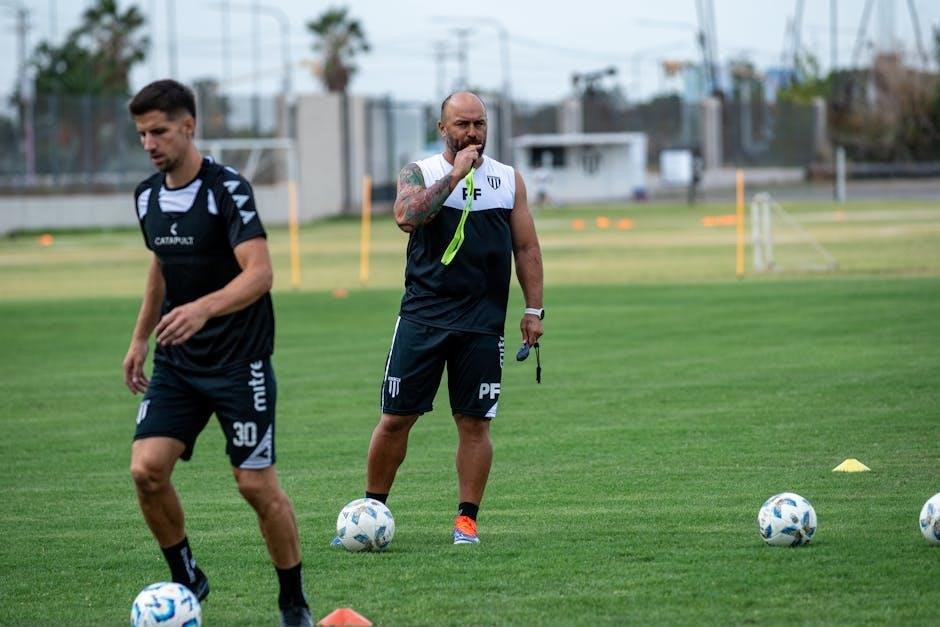
Football training drills are essential for improving technical skills, physical performance, and tactical awareness. Structured drills enhance dribbling, passing, shooting, defense, and agility, ensuring versatile skill development for players of all levels. Effective training programs, often detailed in PDF guides, provide coaches and players with organized sessions to maximize progress and achieve game success.
Overview of the Importance of Structured Training
Structured training is crucial for consistent skill development and performance improvement in football. It ensures players focus on specific aspects of the game, such as dribbling, passing, and defense, in a progressive manner. A well-organized training program, often detailed in PDF guides, helps coaches and players track progress and achieve set goals. By following a structured approach, athletes can enhance their technical abilities, physical fitness, and tactical awareness, leading to better teamwork and game execution. This method also allows for personalized attention and addressing of individual weaknesses, fostering a balanced and effective training environment for all skill levels.
Benefits of Using a PDF Guide for Football Drills
A PDF guide for football drills offers a structured and organized approach to training, providing players and coaches with a clear roadmap for improvement. These guides often include a variety of exercises tailored to specific skills, such as dribbling, passing, and shooting, ensuring comprehensive development. PDF formats are easily accessible and portable, allowing for seamless practice planning and execution. They also enable coaches to track progress and adapt drills to suit different skill levels and team needs. With detailed instructions and visual aids, PDF guides make complex techniques easier to understand and implement, fostering a more efficient and effective training experience for all involved.
Dribbling Drills
Dribbling drills enhance ball control, speed, and agility. Cone exercises, zig-zag patterns, and circle drills improve precision and confidence, helping players master advanced techniques and game situations effectively.
Cone Dribbling Exercises
Cone dribbling exercises are fundamental for improving ball control and agility. By weaving through cones set in straight lines, zig-zag patterns, or circles, players develop precision and speed. These drills enhance a player’s ability to maintain possession in tight spaces and navigate the field effectively. Coaches often incorporate variations, such as time trials or adding defensive pressure, to simulate game scenarios. Proper footwork and dribbling techniques are emphasized to ensure players can execute moves confidently during matches. Regular practice of cone drills builds the foundation for more complex skills, making them a cornerstone of any football training program.
Zig-Zag Dribbling Through Cones
Zig-zag dribbling through cones is a dynamic drill that challenges players to maintain control while changing direction quickly. By setting up cones in a zig-zag pattern, players practice shifting their weight, using different parts of their feet, and keeping the ball close. This exercise improves agility, balance, and reaction time. Coaches often add variations, such as increasing speed or incorporating moves like step-overs or inside cuts, to simulate real-game scenarios. Mastery of zig-zag dribbling enhances a player’s ability to evade defenders and maintain possession in tight spaces, making it a valuable addition to any training routine focused on technical development.
Dribbling in Circles or Patterns
Dribbling in circles or patterns is a fundamental drill that enhances ball control and precision. Players navigate the ball through cones arranged in circular or intricate patterns, focusing on close touches and quick directional changes. This exercise improves coordination, agility, and the ability to maintain possession in tight spaces. Coaches often vary the drill by increasing speed or adding moves like inside and outside cuts, fostering adaptability. Mastery of these patterns translates to better decision-making and composure during matches, making it a cornerstone of technical development for players at all skill levels.
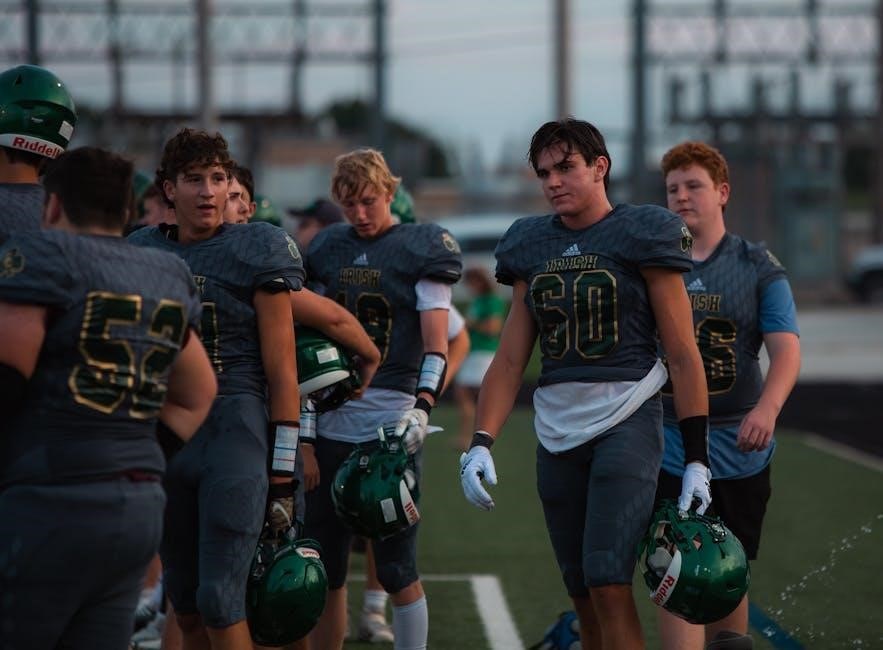
Passing Drills
Passing drills are crucial for developing accuracy, vision, and teamwork. They include short and long distance exercises, one-touch and two-touch passes, and weak foot practice to enhance control and precision, essential for maintaining possession and creating scoring opportunities.
Short and Long Distance Passing Exercises
Short and long distance passing exercises are fundamental for improving accuracy and control. Players start with short passes, focusing on technique, and gradually increase distance to build strength and precision. These drills enhance vision and communication, essential for effective gameplay. Varying distances challenge players to adapt their passing style, ensuring versatility in different match scenarios. Incorporating movement and pressure adds realism, preparing players for real-game situations where quick, accurate passes are crucial. These exercises are vital for all skill levels, fostering consistency and confidence in a player’s ability to deliver precise passes across the field.
One-Touch and Two-Touch Passing Drills
One-touch and two-touch passing drills focus on quick decision-making and precise ball control. Players practice passing with minimal contact, enhancing their ability to maintain possession and create scoring opportunities. These exercises simulate game scenarios, where rapid passes are essential for outpacing defenders. Drills often involve pairs or small groups, encouraging sharp movements and accurate deliveries. Coaches emphasize proper foot placement and body positioning to ensure clean, first-time passes. Over time, these drills improve reaction time and spatial awareness, helping players excel in fast-paced, competitive environments. They are indispensable for developing the instinctive passing skills needed at higher levels of play.
Weak Foot Passing Practice
Weak foot passing practice is crucial for developing balanced gameplay and unpredictability on the field. Players often rely on their dominant foot, but a strong weak foot enhances overall ability. Drills focus on passing accuracy, power, and technique using the non-dominant foot. Exercises begin with stationary passes, gradually incorporating movement and game-like scenarios. Partner drills involve passing back and forth, emphasizing proper foot placement and follow-through. Controlled games, such as 3v3, encourage weak foot usage in competitive situations. Consistent practice fosters confidence and proficiency, allowing players to become two-footed threats. This skill is vital for outsmarting defenders and controlling the tempo of the game.
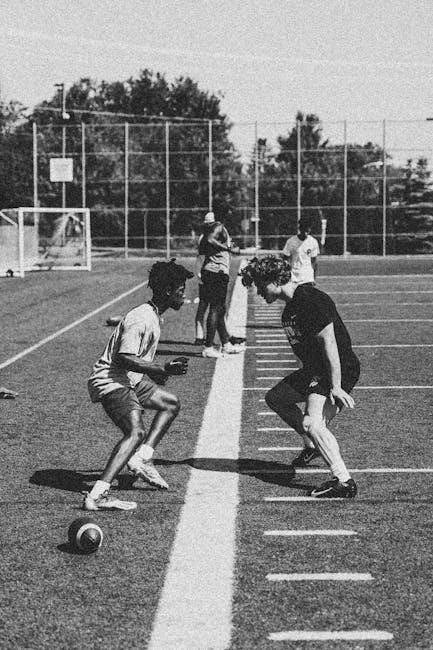
Shooting Drills
Shooting drills focus on enhancing accuracy, power, and technique. Practices include volleys, half-volleys, and breakaway shots, helping players polish finishing skills for game success.
Accuracy Shooting from Different Distances
Accuracy shooting drills are designed to refine a player’s ability to score from various distances. Start with short-range shots to build confidence and technique, then progress to mid and long-range attempts. Incorporate volleys and half-volleys to simulate game situations. Players should focus on proper ball striking, using the laces or inside of the foot, and aim for specific targets like corners of the goal. Drills can include time constraints or pressure from defenders to mimic real-game intensity. Consistent practice improves precision and composure, enabling players to excel in critical moments. Varying the angle and distance keeps the drill dynamic and challenging, ensuring comprehensive skill development.
Volley and Half-Volley Shooting Practice
Volley and half-volley shooting drills enhance a player’s ability to score from crosses and aerial balls. Players practice striking the ball in the air with precision. Drills involve chipping the ball from different heights and distances, focusing on timing and technique. Use both feet for versatility. Incorporate movement and pressure from defenders to simulate game scenarios. Aim for specific areas of the goal to improve accuracy. Consistent practice builds confidence and composure, allowing players to excel in critical moments. Varying the delivery and angle keeps the drill engaging and effective, ensuring well-rounded skill development for match readiness.
Breakaway Shooting Drills
Breakaway shooting drills simulate one-on-one situations with the goalkeeper, enhancing speed, composure, and decision-making. Players practice sprinting towards the goal, controlling the ball, and selecting the best moment to shoot. Drills vary with defenders applying pressure or changing angles. Focus on accuracy and power, aiming for corners. Rotate shooters and goalkeepers for balanced practice. Incorporate moves like feints or step-overs to test skill under pressure. Timed drills increase intensity, mimicking real game scenarios. Consistent practice builds confidence and sharpness, preparing players for critical scoring opportunities. These drills are vital for developing clinical finishing skills and mental toughness in high-pressure situations, ensuring players capitalize on breakaways effectively.
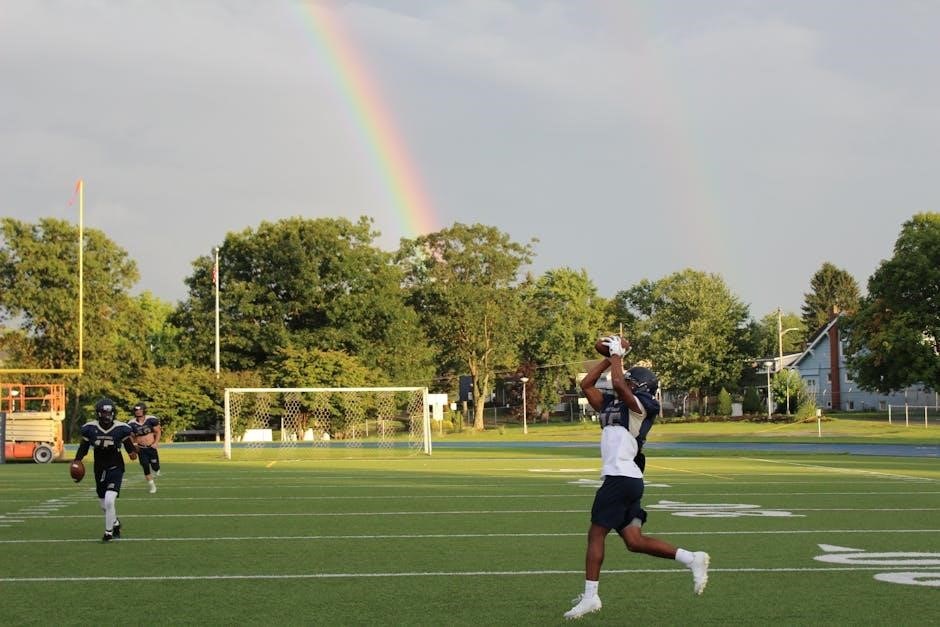
Defensive Drills
Defensive drills focus on strengthening tackling, positioning, and interception skills. Players practice sliding tackles, blocking shots, and maintaining defensive shape. These exercises enhance teamwork and communication, ensuring a solid backline.
Sliding Tackle Practice
Sliding tackle drills teach players to win the ball safely and effectively. Start with controlled exercises where players practice proper tackling technique, focusing on timing and balance. Use cones or markers to create a channel for players to slide through, ensuring they lead with the correct foot. Gradually introduce moving targets or passes to simulate game scenarios. Emphasize staying low, extending the leg, and retrieving the ball quickly. Variations include tackling from different angles or incorporating a pass immediately after the tackle to maintain possession. Safety is crucial, so ensure players avoid contact with opponents during drills.
Positional Awareness and Intercept Drills

Positional awareness and intercept drills enhance a player’s ability to read the game and anticipate opponents’ moves. These exercises involve creating scenarios where players must navigate the field, identify passing lanes, and intercept the ball. Divide players into teams and set up a playing area with cones or markers. Encourage movement and communication to disrupt opponents’ passes. Variations include adding flags or small goals to increase complexity. Coaching points focus on staying alert, maintaining proper body positioning, and reacting quickly to interceptions. These drills improve decision-making and defensive instincts, making players more effective in winning the ball back during matches.
Pressure and Cover Defensive Exercises
Pressure and cover drills focus on teaching defenders to apply immediate pressure on the ball while maintaining defensive shape. These exercises simulate game scenarios where defenders must balance pressuring the opponent and protecting space. Set up drills in a grid or open field, starting with 2v1 or 3v2 situations. Players practice closing down the ball carrier while teammates provide cover. Coaching points include staying low, using the inside foot to tackle, and maintaining communication. Progress to dynamic movements, such as recovering from a press or shifting as a unit. These exercises enhance defensive coordination, reaction speed, and decision-making under pressure, fostering a more resilient backline.
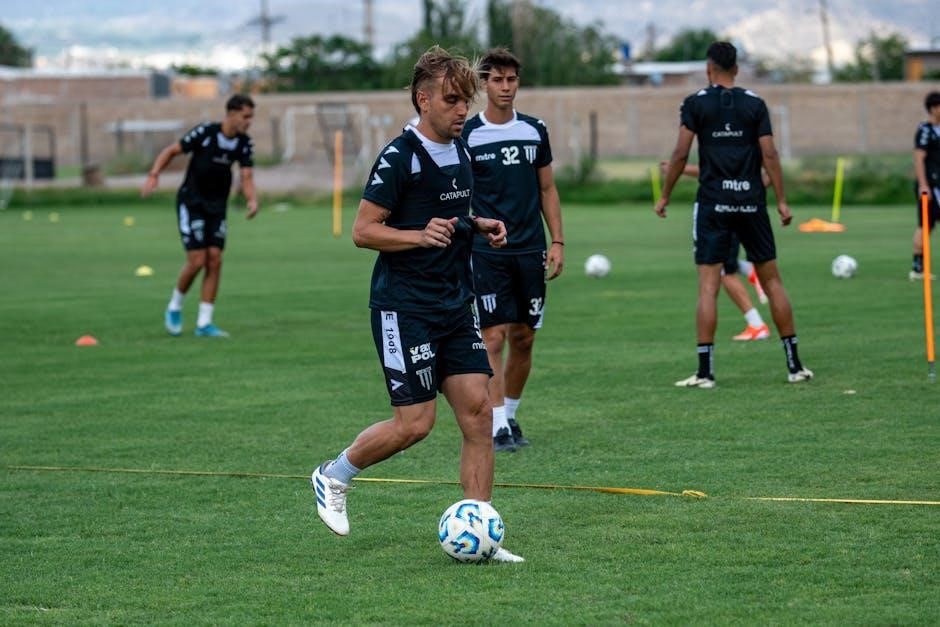
Speed and Agility Drills
Speed and agility drills enhance quick movements, sharp turns, and rapid changes in direction. They improve balance, coordination, and reaction time, essential for outpacing opponents on the field.
Zig-Zag Running Through Cones
Zig-zag running through cones is a fundamental agility drill that enhances speed, balance, and quick directional changes. Players weave through cones arranged in a zig-zag pattern, focusing on rapid foot movements and sharp turns. This exercise improves coordination, acceleration, and the ability to maintain control while changing direction. Proper body positioning and explosive bursts of speed are emphasized to maximize efficiency. The drill can be varied by adjusting cone spacing or adding dribbling challenges, making it suitable for all skill levels. Consistent practice develops the agility needed to outmaneuver opponents during matches.
- Improves agility and balance.
- Enhances quick directional changes.
- Boosts speed and acceleration.
- Develops coordination and footwork.
Hurdle Jumping and Balance Exercises
Hurdle jumping and balance exercises are vital for developing lower-body strength, stability, and coordination. Players jump over hurdles of varying heights, focusing on explosive power and precision. Balance exercises, such as single-leg stands or beam walks, improve stability and reduce injury risk. These drills enhance overall athleticism and adaptability, crucial for quick movements on the field. Incorporating lateral jumps and dynamic balance challenges further refines agility and reaction time, ensuring players can maintain control during fast-paced game situations.
- Enhances lower-body strength and stability.
- Improves balance and coordination.
- Boosts explosive power and agility.
- Reduces injury risk through stability training.
Shuttle Runs for Quick Changes of Direction
Shuttle runs are dynamic drills designed to enhance speed, agility, and rapid directional changes. Players sprint between two points, quickly reversing direction upon reaching each end. This exercise mimics the sharp turns and fast-paced movements common in football. Variations include cone-based courses or ladder drills to add complexity. Proper warm-up is essential to prevent injury, and intensity should gradually increase. Shuttle runs improve acceleration, deceleration, and reaction time, making them a cornerstone of speed and agility training. They are highly effective for developing the explosive movements needed to outmaneuver opponents during matches.
- Enhances speed and agility.
- Improves quick directional changes.
- Boosts acceleration and reaction time.
- Simulates game-like movements.
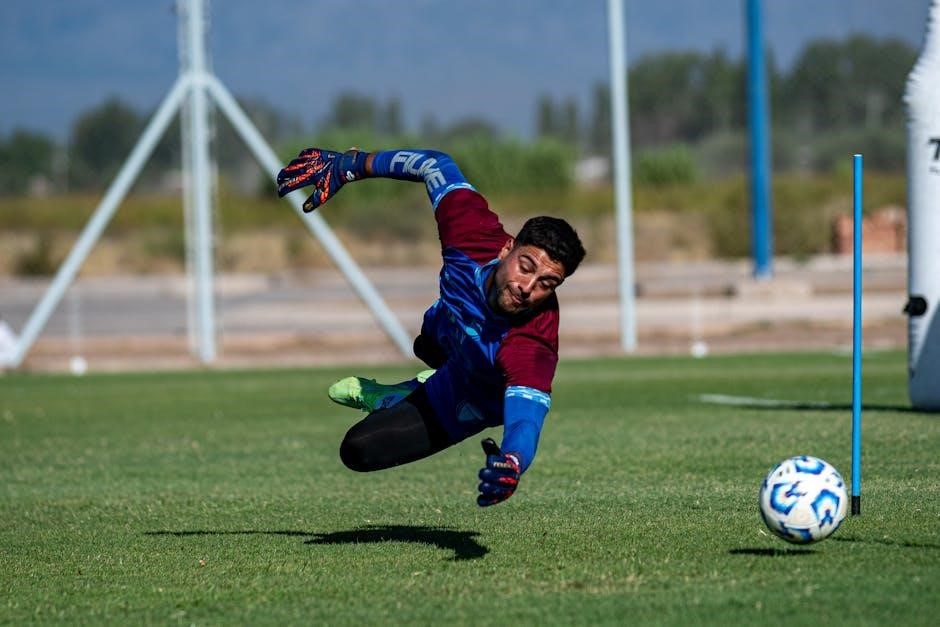
Goalkeeper Training Drills
Goalkeeper drills focus on enhancing reflexes, handling, and distribution. Techniques include catching, diving, and footwork exercises, ensuring keepers excel in shot-stopping and organizing defenses effectively during matches.
Basic Handling and Catching Drills
Basic handling and catching drills are fundamental for goalkeepers to develop essential skills. These exercises focus on proper glove work, body positioning, and reaction time. Coaches often use high repetition drills, such as catching high balls, diving saves, and parrying shots, to build confidence and reflexes. Players practice handling different types of crosses and shots, ensuring they can securely grasp or deflect the ball. These drills also emphasize footwork and distribution, allowing keepers to quickly transition from defense to counter-attacks. Regular practice of these drills improves a goalkeeper’s ability to command their box and protect the net effectively during matches.
Divng and Reaction Saves Practice
Diving and reaction saves are critical for goalkeepers to master, as they often determine the outcome of crucial moments in a match. These drills focus on improving a goalkeeper’s ability to quickly react to shots and crosses while maintaining proper diving technique. Coaches use a variety of exercises, such as shot drills from different angles and heights, to simulate game-like scenarios. Players practice diving forward, sideways, and backward, ensuring they can cover all areas of the goal. Reaction saves are further enhanced through unpredictability, with shooters changing direction or speed to test the keeper’s reflexes. These drills build confidence, agility, and the ability to make split-second decisions, ultimately improving overall performance in high-pressure situations.
Distribution and Kicking Drills
Distribution and Kicking Drills
Distribution and kicking drills are vital for goalkeepers to master the art of restarting play effectively. These exercises focus on improving accuracy, power, and technique in various kicking styles, such as instep kicks, side-foot kicks, and drop kicks. Goalkeepers practice distributing the ball to specific targets, like teammates or zones, to enhance decision-making and precision. Drills often involve scenarios where keepers must kick the ball under pressure or from different angles, simulating game-like situations. Proper foot placement, follow-through, and body balance are emphasized to ensure consistency and control. These drills not only improve distribution skills but also build confidence, enabling goalkeepers to contribute meaningfully to their team’s offensive and defensive strategies.
Creating a Structured Training Program
A well-structured training program includes warm-ups, progressive drills, and game situations to enhance skills systematically. It ensures a balanced focus on technique, fitness, and tactical awareness for optimal development.
Warm-Up and Cool-Down Routines
A proper warm-up and cool-down are crucial for injury prevention and performance optimization. Begin with light jogging, dynamic stretches, and ball control exercises to prepare muscles and focus the mind. Incorporate activities like high knees, leg swings, and shuttle runs to boost circulation and flexibility. Gradually transition into sport-specific movements, such as dribbling drills or passing exercises, to elevate heart rates and coordination. After training, cool down with static stretches, deep breathing, and gentle mobility exercises to aid recovery and reduce muscle tension. A balanced routine ensures players are physically and mentally prepared for drills and aids in post-session recovery.
Progressive Drill Sequencing
Progressive drill sequencing ensures players gradually build skills by increasing difficulty. Start with foundational exercises, such as basic dribbling or short passing, to establish technique. As players gain confidence, introduce variations like zig-zag cone drills or one-touch passes to challenge their abilities. Each subsequent drill should logically build on the previous one, incorporating new elements like speed, agility, or game-like scenarios. This methodical approach prevents plateaus and enhances overall development. Coaches can tailor sequences to address specific weaknesses while maintaining engagement and fostering continuous improvement across all aspects of football training. This structured progression maximizes skill mastery and prepares players for competitive play effectively.
Incorporating Game Situations
Incorporating Game Situations
Incorporating game situations into training drills simulates real-match conditions, helping players adapt to the pressures of live gameplay. Drills like 8v8 training games or scenario-based exercises allow players to practice decision-making, positional awareness, and teamwork in dynamic environments. Coaches can design drills that replicate specific in-game challenges, such as switching plays, breaking defensive lines, or capitalizing on counter-attacks. These exercises enhance players’ ability to think critically and react swiftly during matches. By mirroring actual game scenarios, players develop the instincts and confidence needed to perform effectively under pressure, making training sessions more engaging and purposeful for achieving success on the field.
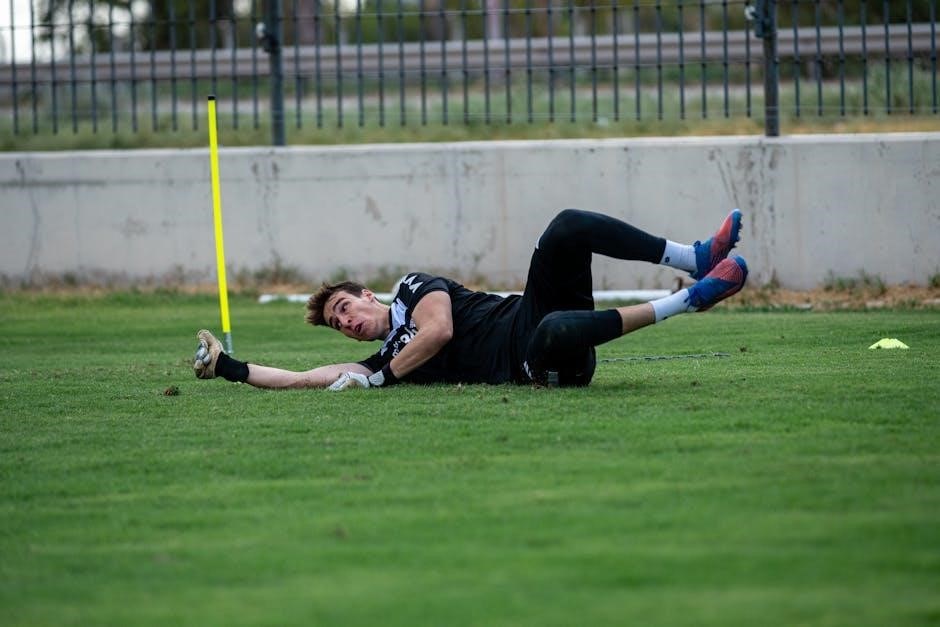
Advanced Training Drills
Advanced drills challenge experienced players with complex exercises like 1v1 scrimmages, multi-faceted skill combinations, and dynamic small-sided games, enhancing speed, agility, and strategic decision-making for elite performance.
1v1 and 2v2 Scrimmage Drills
1v1 and 2v2 scrimmage drills are dynamic exercises designed to enhance players’ decision-making, ball control, and adaptability in tight spaces. These drills simulate real-game scenarios, fostering quick reactions and strategic thinking. In 1v1 drills, players focus on beating opponents with precise dribbling and explosive speed, while 2v2 drills emphasize teamwork, communication, and positional awareness. Both formats improve agility, balance, and the ability to read the game. Coaches often incorporate variations, such as time limits or specific skill focuses, to keep players challenged and engaged. These drills are invaluable for developing the confidence and creativity needed to excel in competitive matches.
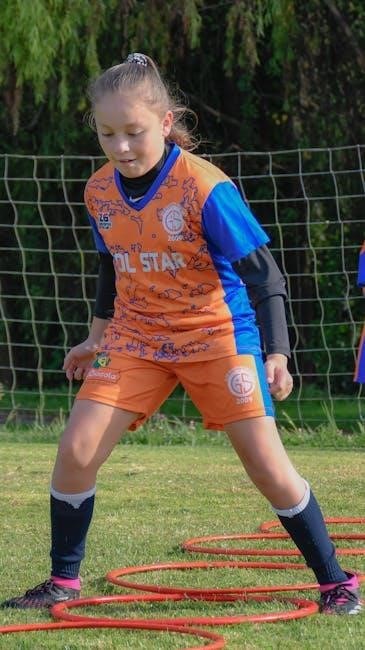
Small-Sided Games for Tactical Awareness
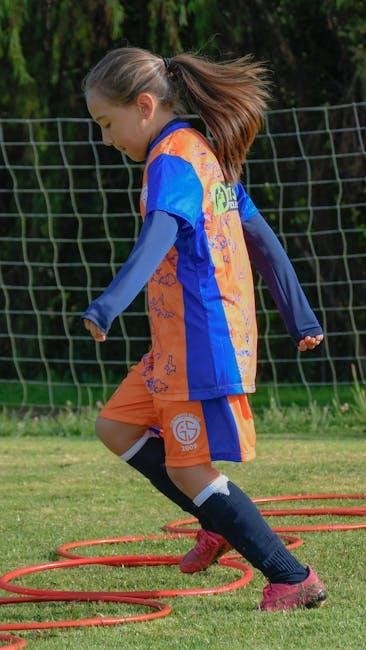
Small-sided games are invaluable for enhancing tactical awareness, as they replicate real match scenarios in a condensed format. These games, typically involving 3v3 to 5v5 players, focus on decision-making, spatial awareness, and teamwork. Players learn to identify scoring opportunities, maintain possession, and adapt strategies. Coaches can modify rules, such as offside restrictions or specific skill focuses, to target areas like passing accuracy or defensive positioning. The reduced field size accelerates the pace, forcing players to think critically and act swiftly. Over time, these exercises improve players’ ability to read the game and execute effective tactics, making them more impactful in full-sided matches.
Multi-Faceted Drills Combining Skills
Multi-faceted drills integrate various football skills into a single exercise, simulating game-like conditions. These drills, such as dribbling through cones followed by passing and shooting, enhance overall performance by combining technical abilities. They improve decision-making, reaction time, and teamwork. Coaches can design drills to focus on specific skill combinations, ensuring players develop a well-rounded game. For example, a drill might involve players dribbling to a designated area, passing to a teammate, and then shooting on goal. This approach not only maximizes practice efficiency but also prepares players for the dynamic nature of real matches, where multiple skills are required simultaneously to achieve success.
Leave a Reply
You must be logged in to post a comment.